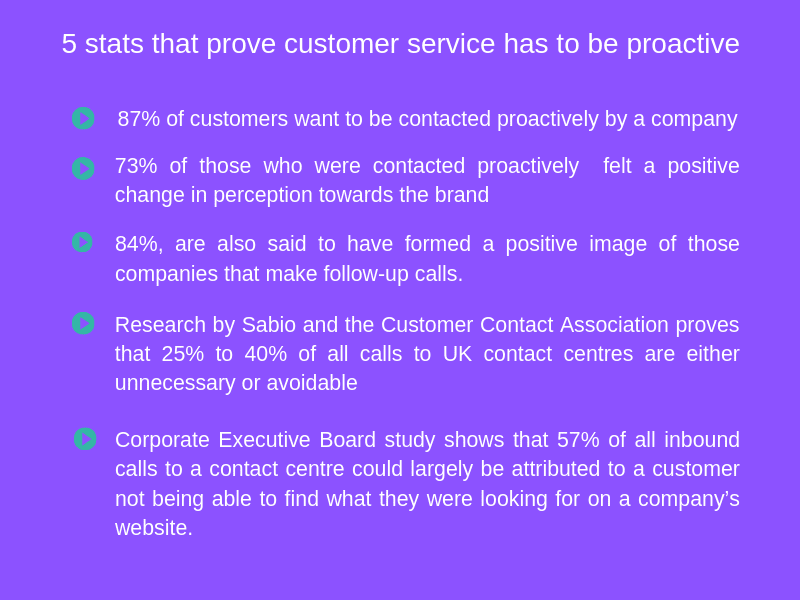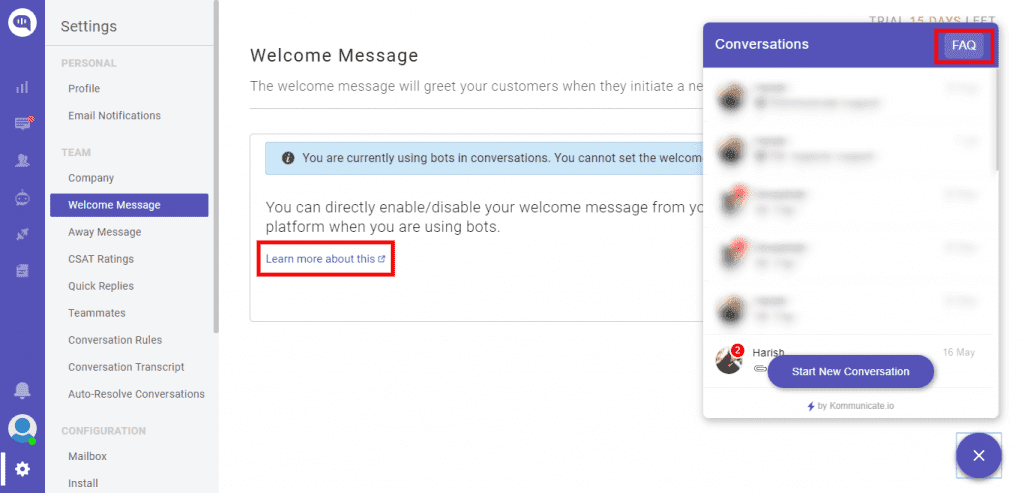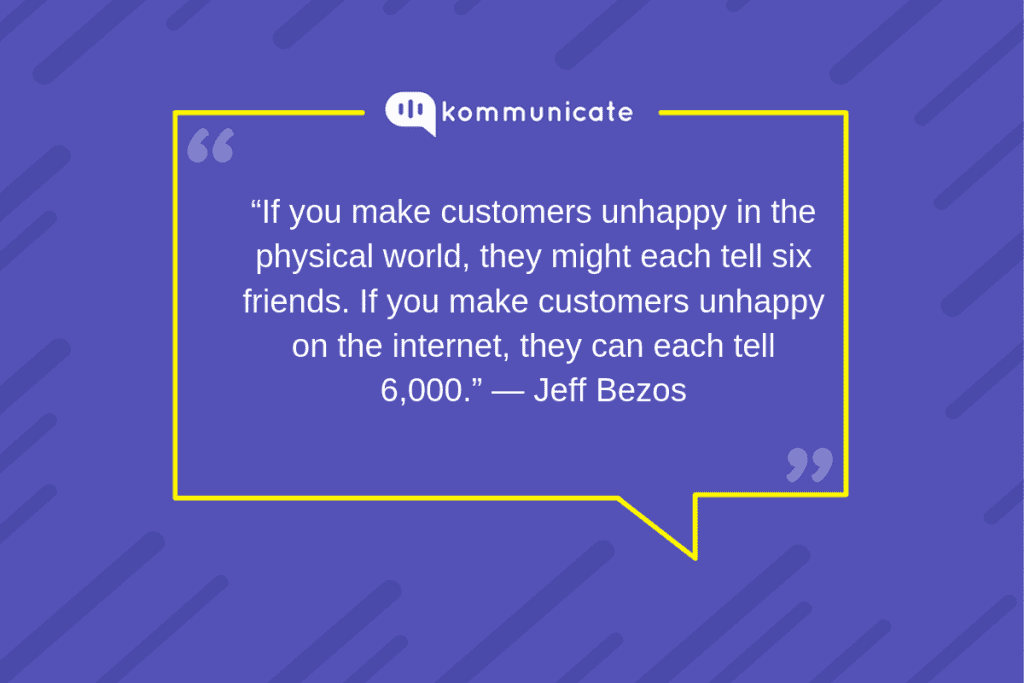Updated on November 17, 2022

“Helping a customer even before they know they need help.”
That is Proactive Customer Service in a sentence for you.
Everyone one of us already aware that customer experience plays an important role in the current competitive market. Gartner’s report also says that 80% of businesses are going to compete based on customer experience in upcoming days.
You might already have an excellent time and putting in the best efforts to support your customers. But you can always do better and wow your customers with proactive customer service.
What is proactive customer service?
There are 2 types of service.
Reactive service: Here companies will address customer queries only when they come up with problems.
Proactive customer service: Here companies will reach out to the customer before they come up with the problem and resolve it.
Most businesses follow the reactive approach but proactive service is proven to improve the brand experience. Reactive customer service is straightforward and comparatively easy but creating loyal customers requires you to go the extra mile.
Difference between reactive and proactive customer service:
| Reactive Customer Service | Proactive customer service |
| Problems are addressed only once they arise. More firefighting and troubleshooting. | Problems are addressed even before they arise. Requires a birds eye view of the entire product cycle. |
| Customer initiates the contact with the company. | Company initiates contact with the customer. |
| Customer’s time and effort is spent, which may lead to an inferior customer experience. | Saves on customer’s time and effort, leading to a positive customer experience, |
| Support channels are generally old-school, like email support or phone-based support. | Utilizes new-age support channels, such as live chat. |
Why proactive service is important?
By nature, we humans seek attention and care. How do you feel when your friend calls to cross-check if you have reached safely or not?
Don’ t you feel special and remember that nice gesture from your friend?
The same psychology applies to proactive customer service.

The basic motto is to create an unmatchable experience and make your customers remember your brand.
In this competitive world, customers have more bargaining and switching power. It’s all about knowing your customers and anticipating their needs.
Today’s consumers do not buy just products or services – more and more, their purchase decisions revolve around buying into an idea and an experience.
– McKinsey
Moreover, proactive customer service helps to reduce the workload of your agents and puts the company in a favorable position with more power.
Benefits
- Increase customer retention: Proactive customer service indirectly increases your engagement with customers which will help you to build a strong relationship with your customer.
Moreover, you will be able to listen to your customers closely and sort out their problems immediately. This will automatically reduce customer churn and increase the retention rate.
2. Acquire new customers: A satisfied customer will tell at least 3 other people about your brand. As per the report, word of mouth drives $6 trillion of annual consumer spending and is estimated to account for 13% of consumer sales. Delighting your existing customer should be your main focus.
3. Create Brand Ambassadors: According to the popular adage, “ A happy customer tells his friends, an unhappy customer tells the world.” Providing Proactive Customer Service means you are making customers feel that your brand really cares about them, and this breeds brand loyalty.
Customers are more likely to purchase from your brand the next time, because they are used to being taken care of. Thus, customers become your biggest brand ambassadors, and proactive customer service can open up doors for you that even the most well-planned marketing campaigns could not.
4. Helps maintain the Brand Image: Customers will talk about your brand, whether you like it or not, and what they speak will mostly be influenced by your product and your service. Providing proactive customer service puts your brand in a positive light, as more and more customers take to social media to talk about brands they love or hate.
For example, in 2005, Jeff Jarvis wrote an article that was strongly worded against Dell on BuzzMachine.com, complaining about Dell’s poor customer service and inferior product. Titled “Dell Hell,” the post was meant to be a mere rant, but soon, hundreds of comments followed where people who faced similar issues posted their woes. Dell has since gone on damage control mode, but the dent made to Dell’s brand image is irreparable.
5. Nip pain points in the bud: A few issues which businesses may consider normal at the beginning can turn out to be real deal-busters to customers, leading to major escalations and projecting the brand in a bad manner. For instance, imagine if you have purchased Sneaker bots from your favorite brand and are expecting delivery within three days. If the brand is facing a delay in keeping up with the surge in demand and cannot deliver on the said date, then proactive customer service would be letting you know that your delivery is delayed.
This will prevent you from waiting for the product for days, which may lead you to becoming a frustrated customer. Remember, in proactive customer service, the company always makes the first move to ensure that customers have the best experience there is.
6. Save Customers time: By offering Proactive Customer Service, companies often anticipate a problem that customers may encounter in the future. By doing this, companies are saving customers precious time, time that the customers can invest in browsing through your product offerings and alter their purchasing decisions. This helps customers realize the value that your business provides to their lives, increasing chances of them making purchases from your brand in the future.
In an ideal scenario, customers don’t have to reach out to your business at all, and as a business, you are preemptively solving customer problems. Any business or service that saves a customer time will succeed over a period of time, and providing proactive customer service gets your business in that category.
7. Reduce the load on support agents: If your customer service is reactive, it means you need to always keep a support agent on standby in case a customer comes to your business with a query. This means greater stress on your support agents, who need to be trained for various scenarios that the customers may face. Employee satisfaction levels are affected, and in the end, your business will start losing the edge it has over the competition.
With proactive customer service, businesses usually address commonly faced issues even before they become major pain points, thereby preventing harried customers from reaching out to support agents. This frees up the supports agents time to provide quality service to the existing customers, which leads to increased customer satisfaction levels. It also reduces the stress on support agents.
How to implement a proactive customer service approach
1) Customer feedback
2) Self-service
3) Analyze user activity on your website
4) Observe what your customer saying online
5) Introduce a “Also Recommended” feature
6) Start an email newsletter
1) Customer feedback:
I know, you’re doing your best to fulfill the needs of your customer.
But how do you know, if your efforts are on the right path or not?
It’s an effective strategy to improve your product and services. There are a lot of different ways to get feedback from your customers such as Email, Online surveys, Livechat, Phone calls.
Once you gather feedback, fix it then and there only. It could be anything such as a bug fix or a user guide. This proactive engagement helps to reduce the problems faced by your customers.
2) Self-service:
Self-serve sources could be anything that can answer your customer queries. Some of the resources are Knowledgebase articles, FAQs, Documentation, Blog posts, Ebooks, Tutorials where customers can find answers to their problems.
Suggested read: Why self helps is the best help?
Your call center or support agent can answer only one customer at a time, right? What if 50 customers have the same problem? Do you ask your agent to provide the same answer to all the customers? or is it better to document the answer and let your customers find it?
Once you have sources, place them in visible places and link it to the answers.
For Example, we have listed out FAQs on a webpage and placed it on your chat widget with a link to all FAQs.
Also in some sections of our Livechat dashboard, we link to tutorials for enabling our customers to understand more about a particular feature.

This provides a better experience for our customers and it helped us to save 30% of operational costs.
>> Looking to deploy your own FAQs on your website? Check Helpcenter.
3) Offer real-time support:
As per the report, 88% of users will not return to the website after a bad experience.
Getting feedback and answering customers’ questions is great.
But offering proactive customer support while customers are browsing your website is a great experience.
You can achieve it by installing live chat on your website. Most of the live chat provides an option to trigger the chat window after a certain duration of time.
To decide on the timing, you can analyze user behavior on your website using Google Analytics or a tool like Hotjar.
Based on this data, you can setup time to trigger the chat window with relevant messages.
You can also check for flaws in your website and fix it for better user experience.
4) Observe what your customer saying online:
Even though social media is overhyped, it still considered as one of the best mediums to interact with your customers.
Now customers are more powerful than before with the revolution of social media. According to a report, solving customer queries through call centers costs you 6X more than on social media.

Here are some simple ways to provide customer service through social media.
- Respond proactively to all the comments and messages.
- Take all the social media feedback constructively and Thank your customers.
- Don’ t wait till your customer tag you.
- Personalize interaction with customers by mentioning their names.
5) Introduce a “Also Recommended” feature
Computer algorithms are super smart these days, and can accurately predict what a customer might need as he browses through your website. Introducing an “also recommended” feature will go a long way in ensuring that customers will continue to browse, and eventually click, on one of your product offerings. Instead of having the customers search for new products on your website, you are letting them know what all you can offer, saving their time and enhancing their experience. This is a prime example of proactive customer service.
6) Start an email newsletter
An excellent way to stay in touch with your customer even after they have made a purchase from your brand is to start an email newsletter. An email newsletter can contain important information about your business, such as new offerings, latest blog posts, changes in the company, industry news, events etc. Make sure that the email newsletter you send out is relevant to your customer.
At Kommunicate, we have a monthly newsletter that covers all of our product offerings, our new releases, latest news from the world of chatbots, and a tutorial on how to build/ integrate chatbots with various 3rd party platforms.
Proactive Customer Service Examples
Some of the more common proactive customer service examples include Slack, which does a killer job of onboarding new customers with its Slackbot. Slackbot identifies new customers and engages them in a conversation, by identifying and matching them with other Slack users who share common interests.
Another example of proactive customer service is from the brand that does almost everything right- Apple. Apple proactively engages with its customers, and had recently launched a “Shot on iPhone” campaign, in which the company encouraged users to shoot photos on their new iPhones, which Apple would then feature on its social media.
Suggested read: How to provide great customer service using social media
These proactive customer service examples showcase that brands, big and small alike, can make their customers loyal to their products by doing tiny things right. You don’t need to spend millions of dollars in advertising if you provide proactive customer service. At the end of the day, the customers should also be a part of your journey.
At Kommunicate, we are envisioning a world-beating customer support solution to empower the new era of customer support. We would love to have you on board to have a first-hand experience of Kommunicate. You can signup here and start delighting your customers right away.






